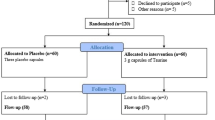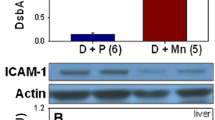Abstract
Hyperglycemia, the hallmark of diabetes mellitus, is considered one of the endothelial dysfunction risk factors, the main reason of vascular complication. In this study, we aimed to evaluate homocysteine (Hcy) and asymmetrical dimethylarginine (ADMA) levels in diabetic rats and the possibility to attenuate the elevation of these two parameters by supplementation of docosahexaenoic acid (DHA) alone or loaded zinc oxide nanoparticles (ZnONPs) to improve endothelial dysfunction in streptozotocin (STZ)-induced diabetic rats. Forty male albino rats weighing 180–200 g were classified as control, diabetic, diabetic treated with DHA, and diabetic treated with DHA-loaded zinc oxide nanoparticles (DHA/ZnONPs) groups. Fasting blood glucose, insulin, ADMA, Hcy, and nitric oxide (NO) were estimated. Fatty acids (linoleic acid (LA), arachidonic acid (AA), DHA, α-linolenic acid (ALA), and oleic acid (OA)) were also evaluated by reversed phase HPLC using a UV detector. The results showed that fasting blood sugar, insulin resistance, LA, AA, OA, ADMA, and Hcy increased significantly in diabetic rats compared with control while fasting insulin, DHA, ALA, and NO decreased significantly in diabetic rats. In both treated groups, fasting blood sugar, insulin resistance, LA, AA, OA, ADMA, and Hcy significantly decreased as compared with the diabetic group while fasting insulin, DHA, ALA, and NO were significantly increased. In conclusion, DHA and DHA/ZnONP supplementation protect against diabetic complications and improve endothelial dysfunction as well as hyperhomocysteinemia in diabetes. DHA/ZnONP-treated group appeared more efficient than DHA alone.





Similar content being viewed by others
References
Nesto, R. W. (2004). Correlation between cardiovascular disease and diabetes mellitus: current concepts. The American Journal of Medicine, 116, 11S–22S.
Sena, C. M., Pereira, A. M., & Seiça, R. (2013). Endothelial dysfunction - a major mediator of diabetic vascular disease. Biochimica et Biophysica Acta, 1832(12), 2216–2231.
Hagiwara, H., Nishiyama, Y., & Katayama, Y. (2011). Effects of eicosapentaenoic acid on asymmetric dimethylarginine in patients in the chronic phase of cerebral infarction: a preliminary study. Journal of Stroke and Cerebrovascular Diseases, 20(5), 474–478.
Korandjia, C., Zeller, M., & Guillanda, J. C. (2011). Time course of asymmetric dimethylarginine (ADMA) and oxidative stress in fructose-hypertensive rats: a model related to metabolic syndrome. Atherosclerosis, 214, 310–315.
Selhub, J. (1999). Homocysteine metabolism. Annual Review of Medicine, 19, 217–246.
Stirban, A., Nandrean, S., Gotting, C., Tamler, R., Pop, A., Negrean, M., et al. (2010). Effects of n-3 fatty acids on macro- and microvascular function in subjects with type 2 diabetes mellitus. The American Journal of Clinical Nutrition, 91(3), 808–813.
Cavieres, V., Valdes, K., Moreno, B., Moore-Carrasco, R., & Gonzalez, D. R. (2014). Vascular hypercontractility and endothelial dysfunction before development of atherosclerosis in moderate dyslipidemia: role for nitric oxide and interleukin-6. American Journal of Cardiovascular Disease, 4(3), 114–122.
Alkaladi, A., Abdelazim, A. M., & Afifi, M. (2014). Antidiabetic activity of zinc oxide and silver nanoparticles on streptozotocin-induced diabetic rats. International Journal of Molecular Sciences, 15(2), 2015–2023.
Yih, T. C., & Al-Fandi, M. (2006). Engineered nanoparticles as precise drug delivery system. Journal of Cellular Biochemistry, 97(6), 1184–1190.
Hirst, S. M., Karakoti, A. S., Tyle, R. R. D., Sriranganathan, N., Seal, S., & Reilly, C. M. (2009). Anti-inflammatory properties of cerium oxide nanoparticles. Small, 5(24), 2848–2856.
Hussein, J., El-Bannaa, M., Abdel Razikb, T., & El-Naggar, M. E. (2018a). Biocompatible zinc oxide nanocrystals stabilized via hydroxyethyl cellulose for mitigation of diabetic complications. International Journal of Biological Macromolecules, 107, 748–754.
Hussein, J., El-Naggar, M. E., Abdel Latif, Y., Medhat, D., El Bana, M., Refaat, E., & Morsy, S. (2018b). Solvent-free and one-pot synthesis of silver and zinc oxide nanoparticles: activity toward cell membrane component and insulin signaling pathway in experimental diabetes. Colloids and Surfaces B: Biointerfaces, 170, 76–84.
Mathews, D. R., Hoker, J. P., Rudenski, A. S., Naylor, B. A., Treacher, D. F., & Turner, R. C. (1985). Homeostasis model assessment: insulin resistance and β-cell function from fasting plasma glucose and insulin concentrations in man. Diabetologia, 28, 412–419.
Sun, Q., van Dam, R. M., Willett, W. C., & Hu, F. B. (2009). Prospective study of zinc intake and risk of type 2 diabetes in women. Diabetes Care, 32(4), 629–634.
Uchiyama, S., & Yamaguchi, M. (2003). Alteration in serum and bone component findings induced in streptozotocin-diabetic rats is restored by zinc acexamate. International Journal of Molecular Medicine, 12, 949–954.
Hussein, J., Attia, M. F., El Bana, M., El-Daly, S. M., Mohamed, N., El-Khayat, Z., & El-Naggar, M. (2019a). Solid state synthesis of docosahexaenoic acid-loaded zinc oxide nanoparticles as a potential antidiabetic agent in rats. International Journal of Biological Macromolecules, 140, 1305–1314.
Trinder, P. (1969). Determination of glucose in blood using glucose oxidase with an alternative oxygen acceptor. Annals of Clinical Biochemistry, 6, 24–27.
Yalow, R., & Bauman, W. A. (1983). Insulin in health and disease. In M. Ellenberg & H. Rifkin (Eds.), Diabetes mellitus: theory and practice (pp. 119–150). New York: Excerpta Medica.
Moshage, H., Kok, B., & Huizenga, J. R. (1995). Nitrite and nitrate determination in plasma: a critical evaluation. Clinical Chemistry, 41, 892–896.
El-Khayat, Z., Abo El-Matty, D., Rasheed, W., Hussein, J., Shaker, O., & Raafat, J. (2013). Role of cell membrane fatty acids in insulin sensitivity in diabetic rats treated with flaxseed oil. International Journal of Pharmacy and Pharmaceutical Sciences, 5(2), 146–151.
Hussein, J., El-Khayat, Z., Morsy, S., Oraby, F., & Singer, G. (2014). The effect of fish oil on oxidant/antioxidant status in diabetic rats through the reduction of arachidonic acid in the cell membrane. International Journal of Pharmacy and Pharmaceutical Sciences, 6(2), 196–199.
Hussein, J. S., Rasheed, W., Ramzy, T., Nabeeh, M., Harvy, M., El-Toukhy, S., Ali, O., Raafat, J., & El-Naggar, M. (2019b). Synthesis of docosahexaenoic acid–loaded silver nanoparticles for improving endothelial dysfunctions in experimental diabetes. Human and Experimental Toxicology, 38(8), 962–973.
Hussein, J., El-Khayat, Z., Abdel Latif, Y., & Khateeb, S. (2016). Quercetin ameliorates endothelial dysfunction and prevents elevation of asymmetrical dimethylarginine in experimental diabetes. Der Pharma Chemica, 8(13), 247–252.
Hussein, J., El-Bana, M., Refaat, E., & El-Naggar, M. E. (2017). Synthesis of carvacrol-based nanoemulsion for treating neurodegenerative disorders in experimental diabetes. Journal of Functional Foods, 37, 441–448.
Shah, P., Zhu, X., Zhang, X., He, J., & Li, C. (2016). Microelectromechanical system-based sensing arrays for comparative in vitro nanotoxicity assessment at single cell and small cell-population using electrochemical impedance spectroscopy. ACS Applied Materials & Interfaces, 8, 5804–5812.
Krishna, D., Rao, S., & Satyanarayana, M. L. (2012). Serum insulin levels and lipid profiles of streptozotocin induced diabetic Wistar rats. Journal Indian Veterinary Association, 10, 22–26.
Kou, L., Du, M., Liu, P., Zhang, B., Zhang, Y., Yang, P., Shang, M., & Wang, X. (2019). Anti-diabetic and anti-nephritic activities of Grifola frondosa mycelium polysaccharides in diet-streptozotocin-induced diabetic rats via modulation on oxidative stress. Applied Biochemistry and Biotechnology, 187, 310–322.
Argacha, J. F., Adamopoulos, D., Gujic, M., Fontaine, D., Amyai, N., Berkenboom, G., & van de Borne, P. (2008). Acute effects of passive smoking on peripheral vascular function. Hypertension, 51(6), 1506–1511.
Sydow, K., Schwedhelm, E., Arakawa, N., Bode-Böger, S. M., Tsikas, D., Hornig, B., Frölich, J. C., & Böger, R. H. (2003). ADMA and oxidative stress are responsible for endothelial dysfunction in hyperhomocysteinemia: effects of l-arginine and B vitamins. Cardiovascular Research, 57(1), 244–252.
Aly, O., Elias, T. R., Agaiby, M. H., Rasheed, W. I., Ashour, M. N., & Hussein, J. S. (2017). Role of a combination of myrtle extract and fish oil supplementation in improving endothelial dysfunction in streptozotocin-induced diabetic rats. Journal of The Arab Society for Medical, 12, 86–91.
Agullo-Ortuno, M. T., Albaladejo, M. D., Parra, S., Rodriguez-Manotas, M., Fenollar, M., Ruíz-Espejo, F., Teba, J., & Martínez, P. (2002). Plasmatic homocysteine concentration and its relationship with complications associated to diabetes mellitus. Clinica Chimica Acta, 326(1–2), 105–112.
Emoto, M., Kanda, H., Shoji, T., Kawagishi, T., Komatsu, M., Mori, K., Tahara, H., Ishimura, E., Inaba, M., Okuno, Y., & Nishizawa, Y. (2001). Impact of insulin resistance and nephropathy on homocysteine in type 2 diabetes. Diabetes Care, 24(3), 533–538.
Tarkun, I., Arslan, B. C., Cantürk, Z., Tarkun, P., Kozdağ, G., & Topsever, P. (2003). Homocysteine concentrations in type 2 diabetes mellitus patients without cardiovascular disease: relationship to metabolic parameters and diabetic complications. Turkish Journal of Endocrinology and Metabolism, 1, 11–17.
Jakubowski, H., Zhang, L., Bardeguez, A., & Aviv, A. (2000). Homocysteine thiolactone and protein homocysteinylation in human endothelial cells. Circulation Research, 87, 45–51.
Akbariana, M., Ghasemib, Y., Vladimir, N., Verskyc, D., & Yousefia, R. (2018). Chemical modifications of insulin: finding a compromise between stability and pharmaceutical performance. International Journal of Pharmaceutics, 547, 450–468.
Dayal, S., & Lentz, S. R. (2005). ADMA and hyperhomocysteinemia. Vascular Medicine, 10, S27–S33.
Fruchart, J. C. (2009). Peroxisome proliferator-activated receptor-alpha(PPARα): at the crossroads of obesity, diabetes and cardiovascular disease. Atherosclerosis, 205(1), 1–8.
Guerre-Millo, M., Gervois, P., Raspe, E., Madsen, L., Poulain, P., Derudas, B., Herbert, J. M., Winegar, D. A., Willson, T. M., Fruchart, J. C., Berge, R. K., & Staels, B. (2000). Peroxisome proliferator-activated receptor α activators improve insulin sensitivity and reduce adiposity. The Journal of Biological Chemistry, 275(22), 16638–16642.
Serhan, C. N., Arita, M., Hong, S., & Gotlinger, K. (2004). Resolvins, docosatrienes, and neuroprotectins, novel omega-3-derived mediators, and their endogenous aspirin triggered epimers. Lipids, 39(11), 1125–1132.
Mozaffarian, D., & Wu, J. H. (2011). Omega-3 fatty acids and cardiovascular disease: effects on risk factors, molecular pathways, and clinical events. Journal of the American College of Cardiology, 58(20), 2047–2067.
Huang, T., Wahlqvist, M. L., & Li, D. (2010). Docosahexaenoic acid decreases plasma homocysteine via regulating enzyme activity and mRNA expression involved in methionine metabolism. Nutrition, 26(1), 112–119.
Shaheen, T., El-Naggar, M. E., Hussein, J. S., El-Bana, M., Emara, E., El-Khayat, Z., Moustafa, M. G., Hossam, F. E., & Hebeisha, A. (2016). Antidiabetic assessment; in vivo study of gold and core-shell silver-gold nanoparticles on streptozotocin-induced diabetic rats. Biomedicine & Pharmacotherapy, 83, 865–875.
Hussein, J., El-Banna, M., Mahmoud, K. F., Morsy, S., Abdel Latif, Y., Medhat, D., Refaat, E., Farrag, A. H., & El-Daly, S. M. (2017). The therapeutic effect of nano-encapsulated and nano-emulsion forms of carvacrol on experimental liver fibrosis. Biomedicine & Pharmacotherapy, 90, 880–887.
Acknowledgments
The authors are grateful to the National Research Centre, Giza, Egypt, for funding this work (internal project no. 11010130).
Author information
Authors and Affiliations
Corresponding author
Ethics declarations
Conflict of Interest
The authors declare that they have no conflict of interest.
Additional information
Publisher’s Note
Springer Nature remains neutral with regard to jurisdictional claims in published maps and institutional affiliations.
Rights and permissions
About this article
Cite this article
Hussein, J., El-Naggar, M., Badawy, E. et al. Homocysteine and Asymmetrical Dimethylarginine in Diabetic Rats Treated with Docosahexaenoic Acid–Loaded Zinc Oxide Nanoparticles. Appl Biochem Biotechnol 191, 1127–1139 (2020). https://doi.org/10.1007/s12010-020-03230-z
Received:
Accepted:
Published:
Issue Date:
DOI: https://doi.org/10.1007/s12010-020-03230-z




